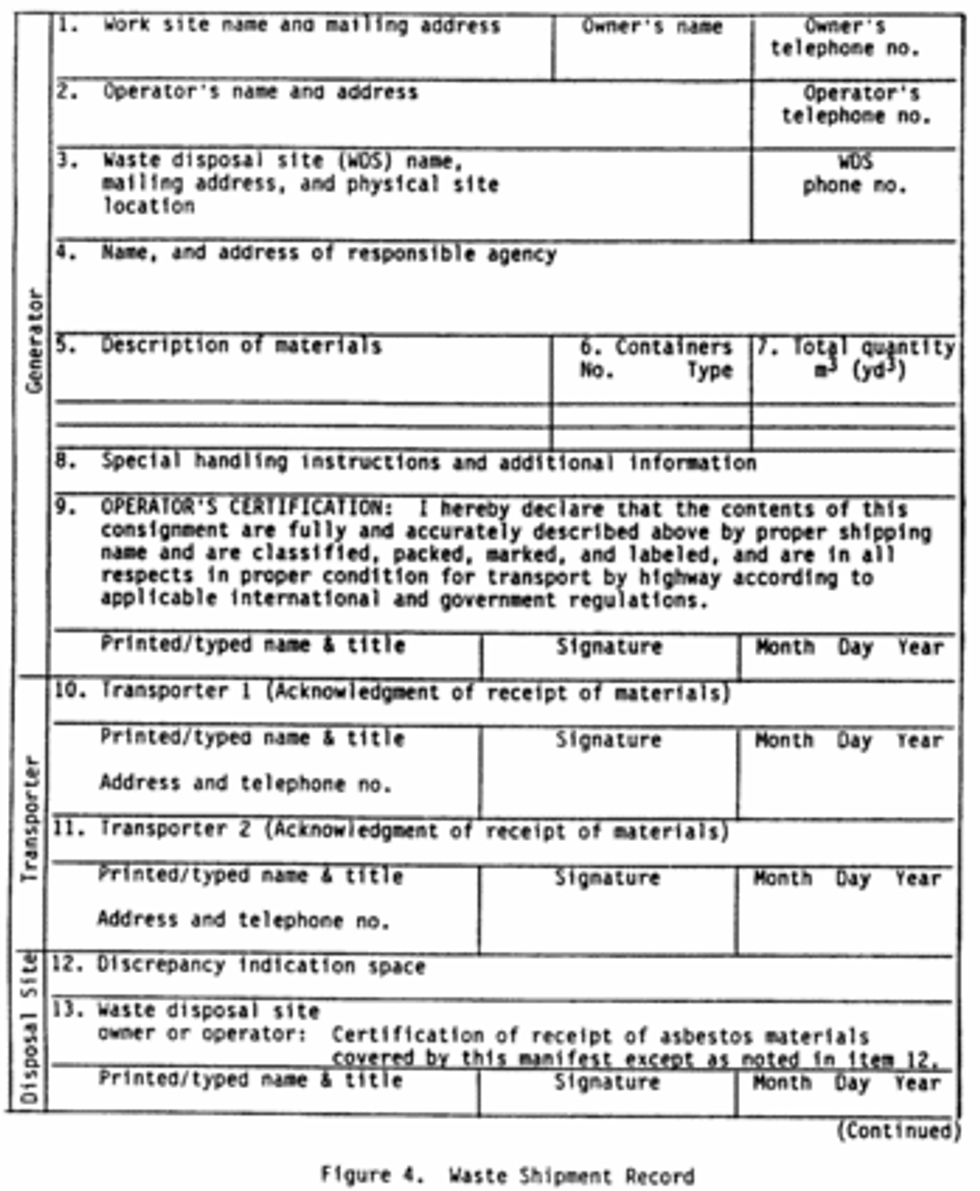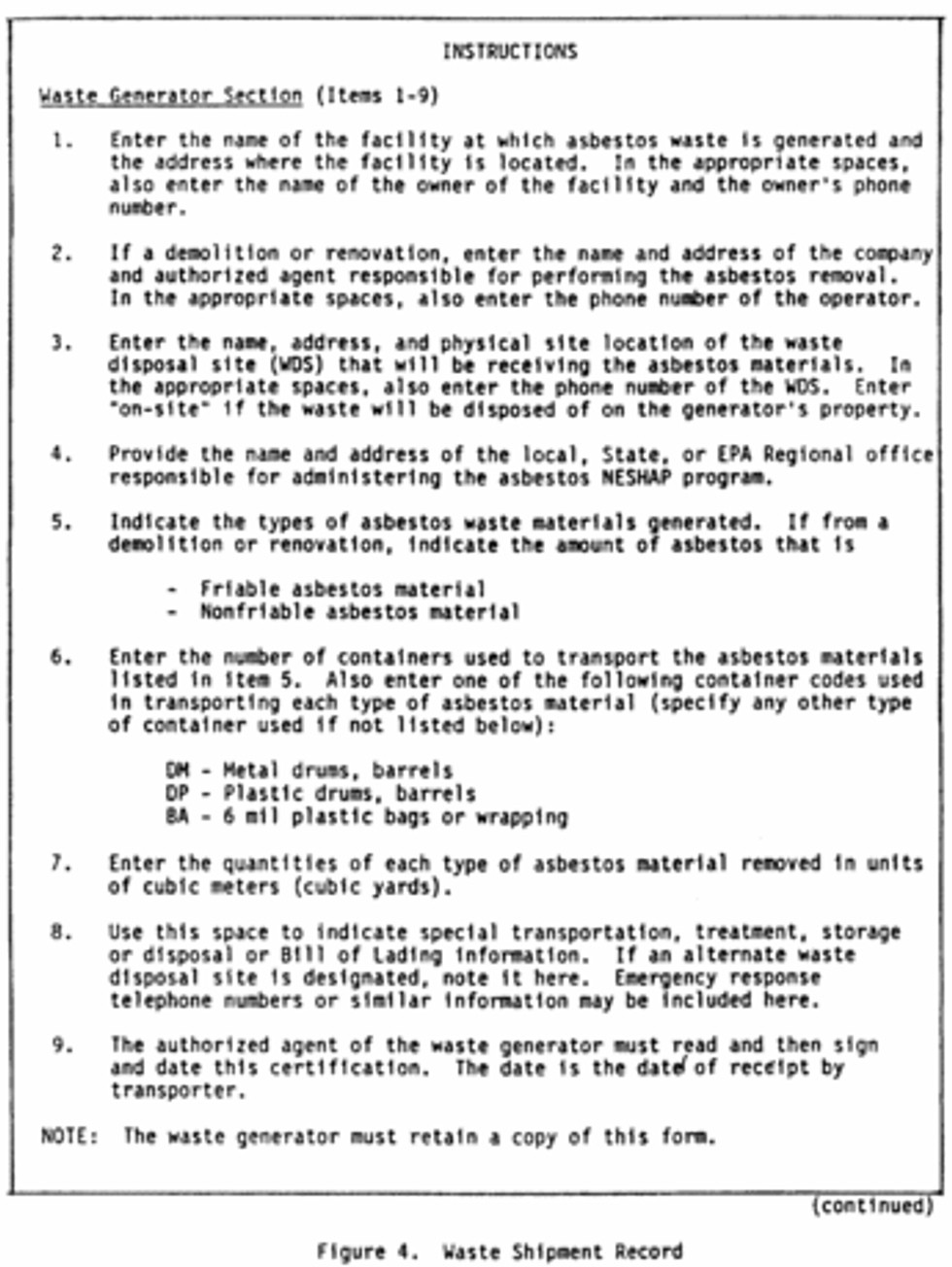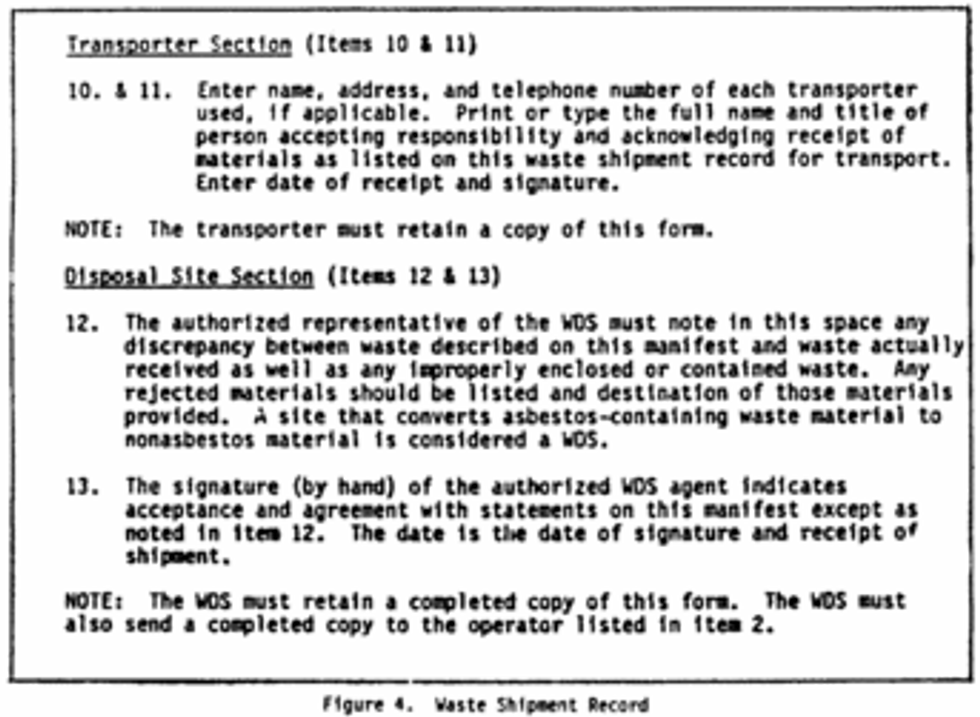['Air Programs']
['Hazardous Air Pollutants']
02/25/2022
...
Each owner or operator of any source covered under the provisions of �61.142 shall:
(a) Deposit all asbestos-containing waste material at a waste disposal site operated in accordance with the provisions of �61.154; and
(b) Discharge no visible emissions to the outside air from the transfer of control device asbestos waste to the tailings conveyor, or use the methods specified by �61.152 to clean emissions containing particulate asbestos material before they escape to, or are vented to, the outside air. Dispose of the asbestos waste from control devices in accordance with �61.150(a) or paragraph (c) of this section; and
(c) Discharge no visible emissions to the outside air during the collection, processing, packaging, or on-site transporting of any asbestos-containing waste material, or use one of the disposal methods specified in paragraphs (c) (1) or (2) of this section, as follows:
(1) Use a wetting agent as follows:
(i) Adequately mix all asbestos-containing waste material with a wetting agent recommended by the manufacturer of the agent to effectively wet dust and tailings, before depositing the material at a waste disposal site. Use the agent as recommended for the particular dust by the manufacturer of the agent.
(ii) Discharge no visible emissions to the outside air from the wetting operation or use the methods specified by �61.152 to clean emissions containing particulate asbestos material before they escape to, or are vented to, the outside air.
(iii) Wetting may be suspended when the ambient temperature at the waste disposal site is less than ?9.5�C (15�F), as determined by an appropriate measurement method with an accuracy of �1�C (�2�F). During periods when wetting operations are suspended, the temperature must be recorded at least at hourly intervals, and records must be retained for at least 2 years in a form suitable for inspection.
(2) Use an alternative emission control and waste treatment method that has received prior written approval by the Administrator. To obtain approval for an alternative method, a written application must be submitted to the Administrator demonstrating that the following criteria are met:
(i) The alternative method will control asbestos emissions equivalent to currently required methods.
(ii) The suitability of the alternative method for the intended application.
(iii) The alternative method will not violate other regulations.
(iv) The alternative method will not result in increased water pollution, land pollution, or occupational hazards.
(d) When waste is transported by vehicle to a disposal site:
(1) Mark vehicles used to transport asbestos-containing waste material during the loading and unloading of the waste so that the signs are visible. The markings must:
(i) Be displayed in such a manner and location that a person can easily read the legend.
(ii) Conform to the requirements for 51 cm � 36 cm (20 in � 14 in) upright format signs specified in 29 CFR 1910.145(d)(4) and this paragraph; and
(iii) Display the following legend in the lower panel with letter sizes and styles of a visibility at least equal to those specified in this paragraph.
Legend
DANGER
ASBESTOS DUST HAZARD
CANCER AND LUNG DISEASE HAZARD
Authorized Personnel Only
Notation
2.5 cm (1 inch) Sans Serif, Gothic or Block
2.5 cm (1 inch) Sans Serif, Gothic or Block
1.9 cm ( 3/4 inch) Sans Serif, Gothic or Block
14 Point Gothic
Spacing between any two lines must be a least equal to the height of the upper of the two lines.
(2) For off-site disposal, provide a copy of the waste shipment record, described in paragraph (e)(1) of this section, to the disposal site owner or operator at the same time as the asbestos-containing waste material is delivered to the disposal site.
(e) For all asbestos-containing waste material transported off the facility site:
(1) Maintain asbestos waste shipment records, using a form similar to that shown in Figure 4, and include the following information:
(i) The name, address, and telephone number of the waste generator.
(ii) The name and address of the local, State, or EPA Regional agency responsible for administering the asbestos NESHAP program.
(iii) The quantity of the asbestos-containing waste material in cubic meters (cubic yards).
(iv) The name and telephone number of the disposal site operator.
(v) The name and physical site location of the disposal site.
(vi) The date transported.
(vii) The name, address, and telephone number of the transporter(s).
(viii) A certification that the contents of this consignment are fully and accurately described by proper shipping name and are classified, packed, marked, and labeled, and are in all respects in proper condition for transport by highway according to applicable international and government regulations.
(2) For waste shipments where a copy of the waste shipment record, signed by the owner or operator of the designated disposal site, is not received by the waste generator within 35 days of the date the waste was accepted by the initial transporter, contact the transporter and/or the owner or operator of the designated disposal site to determine the status of the waste shipment.
(3) Report in writing to the local, State, or EPA Regional office responsible for administering the asbestos NESHAP program for the waste generator if a copy of the waste shipment record, signed by the owner or operator of the designated waste disposal site, is not received by the waste generator within 45 days of the date the waste was accepted by the initial transporter. Include in the report the following information:
(i) A copy of the waste shipment record for which a confirmation of delivery was not received, and
(ii) A cover letter signed by the waste generator explaining the efforts taken to locate the asbestos waste shipment and the results of those efforts.
(4) Retain a copy of all waste shipment records, including a copy of the waste shipment record signed by the owner or operator of the designated waste disposal site, for at least 2 years.
(f) Furnish upon request, and make available for inspection by the Administrator, all records required under this section.



['Air Programs']
['Hazardous Air Pollutants']
UPGRADE TO CONTINUE READING
Load More
J. J. Keller is the trusted source for DOT / Transportation, OSHA / Workplace Safety, Human Resources, Construction Safety and Hazmat / Hazardous Materials regulation compliance products and services. J. J. Keller helps you increase safety awareness, reduce risk, follow best practices, improve safety training, and stay current with changing regulations.
Copyright 2025 J. J. Keller & Associate, Inc. For re-use options please contact copyright@jjkeller.com or call 800-558-5011.
